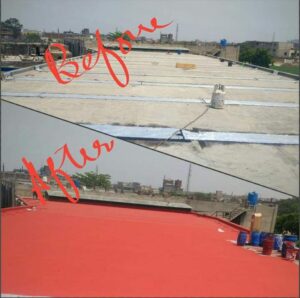Roof Waterproofing Wide Variety Of Materials
In recent years, liquid applied membranes have developed as a feasible, cost-effective, and environmentally friendly option. While evaluating several possibilities, roofing contractors realise that not all “coatings,” as these materials are often called, are created equal. There are a few main types of liquid applied membranes for roofing with Waterproofing in Multan; each of these categories comprises a huge range of products to pick from. Reflexive Waterproofing in Multan, known as “Cool Roof” for its ability to reflect sunlight and lessen the temperature of the roof in direct sunlight, is common nowadays.
When looking for a waterproofing solution for a flat roof, there are many factors to bear in mind (commercial or residential).

How to prepare a roof for waterproofing
Flat roofs that were covered with single-ply roofing membranes like torched-down modified bituminous membranes (mod bit) or EPDM more than three decades ago are suitable candidates for recovery now because of advances in single-ply roofing membrane recovery techniques.
Choosing the proper material for masterrooftreatments begins with the compatibility of the roof surface with the liquid product that will be utilized. Using urethane on a surface covered with acrylic elastomeric is a terrible choice.
Cleaning the substrate properly
A key part of any new deck waterproofing in Multan or current roof system is adhering liquid materials to the clean, bare substrate surface. The newly applied fluid substance’s adherence to the deck’s surface may become weakened or blocked if bond-breakers such as dirt, oil, and dust are present. Bond-breakers include these elements.
If the substrate wasn’t adequately cleaned, this will result in the function of the cured membrane being impaired, as well as an early failure of the component. Pressure washing, which is also used often for the purpose of surface preparation, is the technique that is utilised the most frequently for the purpose of cleaning an existing roof. As a result of this, the most majority of businesses choose to make use of either their very own patented biodegradable detergent or a generic version that is well known.
How to prevent water from penetrating a roof
The installation of roof membranes that have been treated with liquid typically takes place in five phases, and each of these stages needs to be handled with specific care in accordance with the recommendations that are supplied by the manufacturer. This area includes things like cleaning, priming, treating the details, and applying the main coat, to mention just a few of the tasks that fall under this category. Also included in this section is information about the application of the main coat.
The surface of the roof has to be properly cleaned before beginning the process of waterproofing the roof using expert Roof treatments. This marks the beginning of the procedure in its entirety.
As a direct result of this, effectively applying the liquid component and thoroughly cleaning the components are both very crucial steps in the process. When it comes to the cleaning of substrates, pressure washing is by far the most frequent approach utilized. [Case in point] [Case in point] The so-called bond breakers might potentially be eliminated by the use of this strategy. This, among other things, will bring to light issues that in any other circumstance would not have been recognized.
After washing and Leakage solution Multan, the surface is primed in order to enhance the membrane’s adherence.
Handling specifics is the last stage.
Until this stage is done, contractors cannot proceed with the field application of the liquid membrane. In the building business, it is usual practise to treat features such as corners, metal flashing terminations, and penetrations such as pipes, vents, and drains with reinforcing fabric and/or a flashing grade sealant.
Next, the liquid membrane Lekage solution Multan is applied to the roof. Liquid applied membranes may be applied in two ways; some need the use of a reinforcing mat while others don’t. Whether or not a fabric mat is necessary, the majority of manufacturers require two or more successive coating layers. This information may be found in the technical specifications provided by the manufacturer for each coating product.
Adding a layer of protection to a flat roof
In order to successfully waterproof a flat roof, careful application is essential. If a flat roof is “coated,” it doesn’t always indicate that the roof is waterproofed. Roofs with great positive slopes and no standing water near drains are ideal candidates for these coatings from a maintenance perspective.
Even when choosing master Roof treatments and the appropriate certified liquid applied waterproofing membrane, there are various crucial variables that must be considered for the waterproofing work to be completed successfully.
How does the application deal with the possibility of rain?
The roofing contractor must adhere to the manufacturer’s product constraints and ensure that the right application technique is followed. A flat roof may be waterproofed only if the application instructions are strictly followed.

